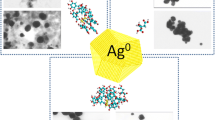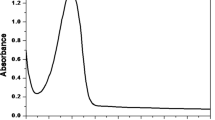Abstract
Gold nanoparticles (Au NPs) were prepared by the reduction of HAuCl4 acid incorporated into the polar core of poly(styrene)-block-poly(2-vinylpyridine) (PS-b-P2VP) copolymer micelles dissolved in toluene. The formation of Au NPs was controlled using three reducing agents with different strengths: hydrazine (HA), triethylsilane (TES), and potassium triethylborohydride (PTB). The formation of Au NPs was followed by transmission electron microscopy, UV–Vis spectroscopy, isothermal titration calorimetry (ITC), and dynamic light scattering (DLS). It was found that the strength of the reducing agent determined both the size and the rate of formation of the Au NPs. The average diameters of the Au NPs prepared by reduction with HA, TES, and PTB were 1.7, 2.6, and 8 nm, respectively. The reduction of Au(III) was rapid with HA and PTB. TES proved to be a mild reducing agent for the synthesis of Au NPs. DLS measurements demonstrated swelling of the PS-b-P2VP micelles due to the incorporation of HAuCl4 and the reducing agents. The original micellar structure rearranged during the reduction with PTB. ITC measurements revealed that some chemical reactions besides Au NPs formation also occurred in the course of the reduction process. The enthalpy of formation of Au NPs in PS-b-P2VP micelles reduced by HA was determined.






Similar content being viewed by others
References
Daniel MC, Astruc D. Gold nanoparticles: assembly, supramolecular chemistry, quantum-size-related properties, and applications toward biology, catalysis, and nanotechnology. Chem Rev. 2004;104:293–346.
Haruta M. Gold as a novel catalyst in the 21st century: preparation, working mechanism and applications. Gold Bull. 2004;37:27–36.
El-Sayed IH, Huang XH, El-Sayed MA. Surface plasmon resonance scattering and absorption of anti-EGFR antibody conjugated gold nanoparticles in cancer diagnostics: applications in oral cancer. Nano Lett. 2005;5:829–34.
Turkevich J, Stevenson PC, Hillier J. A study of the nucleation and growth of processes in the synthesis of colloidal gold. Discuss Trans Faraday Soc. 1951;11:55–75.
Brust M, Walker M, Bethell D, Schiffrin DJ, Whyman R. Synthesis of thiol derivatised gold nanoparticles in a two phase liquid/liquid system. J Chem Soc Chem Commun. 1994;7:801–2.
Teranishi T, Kiyokawa I, Miyake M. Synthesis of monodisperse gold nanoparticles using linear polymers as protective agents. Adv Mater. 1998;10:596–9.
Esumi K, Hara J, Aihara N, Usui K, Torigoe K. Preparation of anisotropic gold particles using a gemini surfactant template. J Colloid Interface Sci. 1998;208:578–81.
Ji X, Song X, Li J, Bai Y, Yang W, Peng X. Size control of gold nanocrystals in citrate reduction: the third role of citrate. J Am Chem Soc. 2007;129:13939–48.
Henglein A. Radiolytic preparation of ultrafine colloidal gold particles in aqueous solution: optical spectrum, controlled growth, and some chemical reactions. Langmuir. 1999;15:6738–44.
Jana NR, Gearheart L, Murphy CJ. Evidence for seed-mediated nucleation in the formation of gold nanoparticles from gold salts. Chem Mater. 2001;13:2313–22.
Bakrania SD, Rathore GK, Wooldridge MS. An investigation of the thermal decomposition of gold acetate. J Therm Anal Calorim. 2009;95:117–22.
Privman V, Goia DV, Park J, Matijević E. Mechanism of formation of monodispersed colloids by aggregation of nanosize precursors. J Colloid Interface Sci. 1999;213:36–45.
Alvarez MM, Khoury JT, Schaaff TG, Shafigullin MN, Vezmar I, Whetten RL. Optical absorption spectra of nanocrystal gold molecules. J Phys Chem B. 1997;101:3706–12.
Mie G. Beitrage zur Optik Truber Medien, Speziell Kolloidaler Metallosungen. Ann Phys. 1908;25:377–445.
Sato S, Toda K, Oniki S. Kinetic study on the formation of colloidal gold in the presence of acetylenic glycol nonionic surfactant. J Colloid Interface Sci. 1999;218:504–10.
Yang S, Wang Y, Wang Q, Zhang R, Ding B. UV irradiation induced formation of Au nanoparticles at room temperature: the case of pH values. Colloids Surf A. 2007;301:174–83.
Patakfalvi R, Papp S, Dékány I. The kinetics of homogeneous nucleation of silver nanoparticles stabilized by polymers. J Nanopart Res. 2007;9:353–64.
Papp S, Dekany I. Nucleation and growth of palladium nanoparticles stabilized by polymers and layer silicates. Colloid Polym Sci. 2006;284:1049–56.
Mössmer S, Spatz JP, Möller M, Aberle T, Schmidt J, Burchard W. Solution behavior of poly(styrene)-block-poly(2-vinylpyridine) micelles containing gold nanoparticles. Macromolecules. 2000;33:4791–8.
Sidorov SN, Bronstein LM, Kabachii YA, Valetsky PM, Lim Soo P, Maysinger D, et al. Influence of metalation on the morphologies of poly(ethylene oxide)-block-poly(4-vinylpyridine) block copolymer micelles. Langmuir. 2004;20:3543–50.
Meristoudi A, Pispas S, Vainosi N. Self-assembly in solutions of block and random copolymers during metal nanoparticle formation. J Polym Sci B. 2008;46:1515–24.
Arcoleo V, Cavallaro G, Manna GL, Liveri VT. Calorimetric investigation on the formation of palladium nanoparticles in water/AOT/n-heptane microemulsions. Thermochim Acta. 1995;254:111–9.
Aliotta F, Arcoleo V, Buccoleri S, La Manna G, Liveri VT. Calorimetric investigation on the formation of gold nanoparticles in water/AOT/n-heptane microemulsions. Thermochim Acta. 1995;265:15–23.
Patakfalvi R, Dékány I. Nucleation and growing of silver nanoparticles under control of titration microcalorimetric experiment. J Therm Anal Calorim. 2005;79:587–94.
Kanemaru M, Shiraishi Y, Koga Y, Toshima N. Calorimetric study on self-assembling of two kinds of monometallic nanoparticles in solution. J Therm Anal Calorim. 2005;81:523–7.
Seregina MV, Bronstein LM, Platonova OA, Chernyshov DM, Valetsky PM, Hartmann J, et al. Preparation of noble-metal colloids in block copolymer micelles and their catalytic properties in hydrogenation. Chem Mater. 1997;9:923–31.
Antonietti M, Wenz E, Bronstein L, Seregina M. Synthesis and characterization of noble metal colloids in block copolymer micelles. Adv Mater. 1995;7:1000–5.
Spatz JP, Sheiko S, Moller M. Ion-stabilized block copolymer micelles: film formation and intermicellar interaction. Macromolecules. 1996;29:3220–6.
Saptz JP, Mössmer S, Hartmann C, Möller M, Herzog T, Krieger M, et al. Ordered deposition of inorganic clusters from micellar block copolymer films. Langmuir. 2000;16:407–15.
Yoon NM, Yang HS, Hwang YS. Reducing characteristics of potassium triethylborohydride. Bull Korean Chem Soc. 1987;8:285–91.
Acknowledgements
The authors are very grateful for the financial support of the MÖB-DAAD project no. 14.
Author information
Authors and Affiliations
Corresponding author
Rights and permissions
About this article
Cite this article
Papp, S., Kőrösi, L., Gool, B. et al. Formation of gold nanoparticles in diblock copolymer micelles with various reducing agents. J Therm Anal Calorim 101, 865–872 (2010). https://doi.org/10.1007/s10973-009-0570-x
Received:
Accepted:
Published:
Issue Date:
DOI: https://doi.org/10.1007/s10973-009-0570-x




